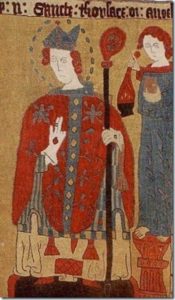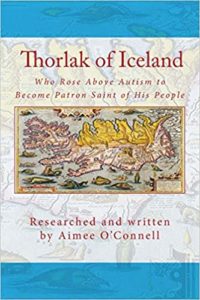The Summer Feast of Saint Thorlák
By Aimee O’Connell |
 Most of us are familiar with Thorláksmessa, the Feast of Saint Thorlák, which Icelanders mark on December 23 as both a salute to the Patron Saint of Iceland and a joyful day of preparation for the Christmas holidays. But few are aware that there is a corresponding Feast of Saint Thorlák celebrated every July 20. This summer Feast of Saint Thorlák is just as solemn a commemoration in the eyes of the Church but lacks the public fanfare and festivity that raises the December date to its status as an Icelandic national holiday.
Most of us are familiar with Thorláksmessa, the Feast of Saint Thorlák, which Icelanders mark on December 23 as both a salute to the Patron Saint of Iceland and a joyful day of preparation for the Christmas holidays. But few are aware that there is a corresponding Feast of Saint Thorlák celebrated every July 20. This summer Feast of Saint Thorlák is just as solemn a commemoration in the eyes of the Church but lacks the public fanfare and festivity that raises the December date to its status as an Icelandic national holiday.
Saint Thorlák Thorhallsson, born in Fljótshlið in 1133, lived a life of holy example culminating in his service as Bishop of Skálholt from 1178 until his death on December 23, 1193. It is often the case that the Catholic Church proclaims feast days on the date of a saint’s death, which is how the date of Thorláksmessa came to be. Thorlák’s sainthood itself, however, was not immediately instituted upon his death. As with all saints of the Church, a period of reflection, study and scrutiny of Thorlák’s life was necessary before anyone could possibly consider him a saint. The hagiography and conclusions of this study are well-detailed in The Saga of Bishop Thorlák, and there is little question that his holiness is exemplary. Furthermore, the Saga contains testimony from numerous people as to the miraculous intercession of Bishop Thorlák on behalf of those who asked his help in prayer. It did not take long for devotion to spread.
In 1198, five years after Thorlák’s death, his successor and nephew, Bishop Páll Jónsson, took formal steps to make Thorlák’s sainthood official. To accomplish this, Thorlák’s body needed to be exhumed and ceremoniously moved to a dedicated place of sacred repose at the Cathedral in Skálholt. A formal declaration would also be made by Bishop Páll at the Althing. These motions were among the many activities which could only be undertaken in the summer months in Iceland when the ground was not frozen and public assemblies were possible. The Althing, for starters, convened for two weeks every June and was attended by those who gathered from all parts of Iceland. And, the formal translation of Thorlák’s relics on July 20, 1198 (i.e., the moving of his body from its initial burial spot to one of sacred veneration) found hundreds of pilgrims crossing the Icelandic terrain to witness this occasion in Skálholt. Thus, the summer Feast of Saint Thorlák is commemorated in the Church every year on this date.
Among the faithful, the practice of a nine-day devotion known as a novena is frequently performed in the days leading up to a particular feast day. The Novena in Honor of Saint Thorlac was approved in 2018 by Bishop David B. Tencer of the Catholic Church in Iceland and is a fine way to learn more about the life and example of Iceland’s patron saint. English text and audio of this prayer is available free online at the Autism Consecrated website, or audio with slideshow on the website’s YouTube channel. The novena may also be purchased in book form from Amazon.com.
Aimee O’Connell is the author of Thorlak of Iceland, published by Chaos to Order Publishing. The book may be ordered at www.amazon.com.
 Iceland’s history is told in the stories of its celebrated figures. From Viking explorers to Saga heroes, the voices that define Icelandic culture are well known. Yet one man in Iceland’s past had difficulty finding the words to form his own voice and be known for who he really was: Thorlák Thórhallsson, declared by his people “The Patron Saint of Iceland” in 1198 and officially canonized by Pope John Paul II in 1984. Yet, despite these honors, few have ever heard Thorlák’s complete and true story: A child prodigy treated as an adult by those around him, a sorrowful boy from a broken home, a scholar of the emerging theology of merciful love, an innovator in pastoral leadership, and a man who understood the fundamental need to love and be loved. Thorlák of Iceland is an opportunity at last to celebrate this quiet hero who embodies the spiritual heart of the Icelandic people, and to learn from his inspiring true story wisdom for our own age.
Iceland’s history is told in the stories of its celebrated figures. From Viking explorers to Saga heroes, the voices that define Icelandic culture are well known. Yet one man in Iceland’s past had difficulty finding the words to form his own voice and be known for who he really was: Thorlák Thórhallsson, declared by his people “The Patron Saint of Iceland” in 1198 and officially canonized by Pope John Paul II in 1984. Yet, despite these honors, few have ever heard Thorlák’s complete and true story: A child prodigy treated as an adult by those around him, a sorrowful boy from a broken home, a scholar of the emerging theology of merciful love, an innovator in pastoral leadership, and a man who understood the fundamental need to love and be loved. Thorlák of Iceland is an opportunity at last to celebrate this quiet hero who embodies the spiritual heart of the Icelandic people, and to learn from his inspiring true story wisdom for our own age.
